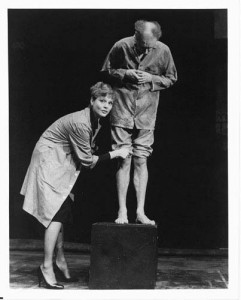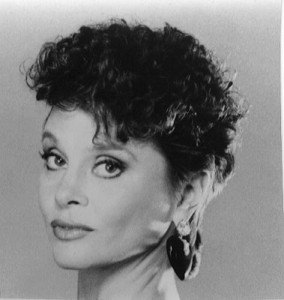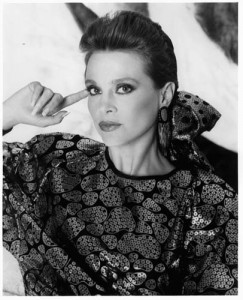The decade of the 80’s covered distinct and certainly diverse areas of my life. I married twice, first to a president of a film studio, and the other a Doctor of Oriental Medicine and a healer. I made two very good movies in the mid-eighties, Secret Admirer and Jagged Edge. I starred for a season on Dallas in a wildly outrageous role that I thoroughly enjoyed. I traveled to Europe with a very fine and prestigious production of The Beckett Plays, and met with Samuel Beckett.
In 1985, I toured Egypt, Israel, Greece and Italy for some months, returning to powerful spiritual roots. This journey activated my desire to be of greater service. I met Ted Turner and became very involved with his Better World Society, and worked for several years on behalf of Ted and his vision for a better world through quality television programming.
I made two more movies in the late-eighties that involved extensive travel. One film was Honeymoon Academy, which kept me in Spain for many months. The second film, Accidents, was three months in South Africa. Both of these films were fascinating experiences.
I ended the decade with a strong desire to work to better the environment. I began working for the United Nations Environment Programme under Dr. Noel Brown as a special consultant in Arts and Media. Olivia Newton-John and I both enjoyed sharing our passion to help raise environmental consciousness. In the nineties, I would heighten this commitment.
The Beckett Plays: Catastrophe
In the summer of 1982, my second marriage was coming to a rapid halt. I had taken a job in New York City shooting five episodes of a new nighttime drama called The Hamptons. My husband had now become president of Columbia Pictures, and with his success he did not care to have me working. He had taken a three week boat trip to Mexico and while he was there I received the offer to do The Hamptons. It was for very little money, but I desperately felt the need for my own self-expression, and acting was my skill. The network needed an immediate answer. Finally I was able to reach my husband in Mexico, and I told him that this was what I needed to do. He agreed. This decision to work again, and be away, proved to be the end of the marriage.

Very quickly I met with Jack Garfein who ran the Off-Broadway Clurman Theatre on 42nd street. A trilogy of one act plays had been running there for a year, called The Beckett Plays. In one of the plays called Catastrophe, the actress needed to leave for a film commitment. She was to be replaced immediately without any performances being missed. The original, and only, director of these plays at The Clurman was Alan Schneider. He was a highly regarded director of Beckett and Pinter. At that moment, he was teaching acting in San Diego at a university.
Jack Garfein asked me if I would like to take the role. I said yes! He told me “the only requirement” would be my willingness to pay for Alan to fly in on Friday from San Diego, and rehearse me all day Saturday. I would then open the very next day, in Sunday night’s performance. Again, I said yes. This was now Wednesday and I had two days to learn the lines before Alan’s arrival. This was no easy task. I had never performed in Beckett and the language appeared almost nonsensical. The cues did not follow regular speech rhythms or thought patterns. These rhythms of speech were musical and so highly stylized that it was a form of poetry.
Still it was quite a task, as my brain was not used to memorizing this kind of text. I used a tape recorder to record the other character’s lines and left empty space for my responses. I needed to learn my cues and my lines by rote. I approached Beckett mechanically at first and then my inner life would have a structure to rely upon. I met Alan in early October on that Saturday morning in the Clurman Theatre for the first and only rehearsal. Alvin Epstein, a fine actor, played the other role of the Dictator. He, of course, was there.
Catastrophe is a fascinating one-act play that Beckett wrote as an homage to Checkoslovakia’s Pavlov Havel. Beckett wrote this play while Havel was still imprisoned as an outspoken dissident in Checkoslovakia. He was freed while The Beckett Plays were still running and went on to become the President of Checkoslovakia.
This particular play is an exquisite tribute to the ability of the human spirit to transcend oppression and torture, and turn it into triumph. As we began to rehearse that Saturday morning, a very elegant and dapper man entered quietly, and sat in the first row without any apology. It was a private rehearsal with an enormous amount to accomplish in the very short time of just one day. His entrance felt a bit intrusive. Alan then introduced me to him, his name was David Warrilow and he also would be appearing in this play. He and Alvin exchanged roles every other performance.
I later learned and experienced that David was a truly great actor, especially of Beckett’s works, as well as other very avant-garde theatrical pieces. He was also a close personal friend of Beckett’s, or “Sam”. David’s speaking voice sounded as if it was from God himself. He was quite a presence. He watched carefully as I continued my intense rehearsal with Alan and Alvin. When the day was done, David called me aside to speak with me. He had come to watch my rehearsal, he said, because he was deeply concerned that a “television” actress had been hired to perform in Beckett. In his eyes, the television style of acting could not possibly translate to Beckett. After watching me, he told me he was impressed with my ability to focus, take direction, and “get” the rhythms and precise timing of Beckett. He also noted that I was already bringing depths of meaning and poignancy to the text. Would I consider auditioning for the role of Hedda in the Tyrone Guthrie production of Hedda Gabler?
He was set to play the role of Dr. Brack, and he felt I would make a magnificent Hedda. I must say, this was one of the greatest compliments I have received in my years of working. David and I became great friends and soon shared profound spiritual interests as well.
I opened the next night, and every one was very pleased. No one was more pleased than I was, as I had accepted the challenge, climbed the “mountain” at a rapid pace and metaphorically planted the flag. I went on to travel with The Beckett Plays to the Edinburgh Festival, to London, and to the Mark Taper Theatre in Los Angeles. The production was soon joined by the great Billy Whitelaw in Beckett’s Rocking Chair. In each venue, The Beckett Plays were impeccably produced with fine performances, and we received wonderful reviews. I wrote Samuel Beckett from Edinburgh. It was a letter of love, regard and gratitude. He responded, and we met in Paris and spent a glorious day together.
My work in these plays reignited my creativity and passion for my own abilities, and the desire to share my talent. The evening I closed in London, I flew back to Los Angeles to begin shooting the very next day in a film for United Artists called Secret Admirer. This was a light-hearted American farce. I was playing a “Valley wife”. In the very first scene we filmed, I was engaged in an outrageous food fight. Talk about shifting! From Beckett to a food fight. The next chapter had begun.
Learn More About The Beckett Play: Catastrophe
Jagged Edge

In January of 1985, shortly after I had completed Secret Admirer, my agent at ICM told me about a very good feature being made at Columbia called Jagged Edge. Joe Eszterhas wrote the script. Glenn Close and Jeff Bridges were set to star with Richard Marquand as director. There was a very small role in it that she felt I should consider. When she told me that it was only a three page scene, I was upset, as I had just completed Secret Admirer in one of the lead roles. Here is where an agent who has a good managerial mind is very beneficial for an actor. Her point of view was that Jagged Edge was excellent in the writing, in the cast and in the director. The character, Virginia Howell, has a moment on film in which she impacts all of the other key characters in a very dramatic way, mainly Jeff Bridges and Glenn Close. Therefore, she was not an inconsequential character.
I read the scene and only after meeting Richard Marquand did I agree. He, as well, pointed out that the scene had importance to the movement of the story. It was the respect he extended toward me, and his intelligence, that convinced me that it was not a bad career move. There was only one other person who needed to approve my being hired. This man was the president of the studio, from whom I would soon be divorced. How ironic it was. He had not wanted me to work while we were married. Now he enthusiastically approved my employment in this film. He was, in fact, the first to call me after the scene was viewed in “dailies”, and tell me how outstanding my performance was.
As it was but one scene in which I would appear, I was hired for only three days. I remember my first morning in the make up trailer with Glenn Close, whom I knew, and Jeff Bridges and Peter Coyote. Glenn and I had been in New York working in 1982. She was in Tom Stoppard’s play The Real Thing with Jeremy Irons and I was in The Beckett Plays. When you work on Broadway, or off – Broadway, there is a bond of friendship amongst actors that is a democratic acceptance that we are all artists. In Los Angeles, and the film industry, there is more focus on status, or a “pecking order” of importance in your “stardom”. Even though Glenn was the female star of Jagged Edge, we greeted each other warmly and chatted about mutual friends. Jeff Bridges was equally warm and welcoming.
My scene took place in the courtroom. I was a witness on the witness stand. Jeff Bridges’ character was on trial. It was a very big scene with many extras. Glenn had a lot of dialogue, as did Peter Coyote. Jeff had to sit and react. Because they were the stars, their scenes would be shot first. This had great value for me at that moment. I would have time to absorb and further prepare the inner dynamics between my character and everyone else. By 7 pm of the third day, they were finally ready for my scene. I was tired, as I had had to sit on the witness stand for the other actor’s performances now for three long days. Richard asked me how I felt. Did I want to “go for it” and do the scene that night, or start fresh the next morning. He asked Glenn and Jeff and Peter if they would stay for me. They all said “absolutely yes,” they would stay.
Richard encouraged me to do the scene that night. He was right. I was internally very edgy as I had had to wait so long and no longer felt fresh. My moment to perform had arrived. I felt insecure that I now might not be able to “come up” with what I needed. My insecurity and the situation made me very angry. Richard intuited my emotional state without outwardly speaking of it. He wanted to “use” it. He later told me the situation was perfect, as he felt I was so naturally nice, and the character was such a cold bitch, he wanted me to be organically closer to the nature of the character. He also said later, that he trusted me as a professional. He knew I would use my internal state and “channel” it into Virginia Howell. He was so right. Anger was not a very familiar state for me, and given that I was “in it” it was indeed perfect timing to use it to express the character. It also allowed me to throw away my considerations of Glenn or Jeff or Peter’s opinion of my performance. I simply did it. If I had chosen the next morning, I would have been back in my happier state facing more of a challenge to make it real. An actor uses absolutely everything he or she can to reach emotionally honest moments. These moments need to be magically expressed on “action!”
Jagged Edge was an outstanding thriller and very successful. It assisted me career-wise to open up the Industry’s view of me as a dramatic actress. When you have a long career, it is important, in my opinion, to keep shattering others’ creative perception of you, so you can be hired in a wider range of roles.
Jagged Edge on IMDB
Dallas

In the summer of 1987, I was in Paris shooting a Movie of the Week for David Wolper called Napoleon and Josephine. The day I was leaving Paris to return home, my agent called and asked if I would be interested in doing two episodes of the hit television show, Dallas, in a guest appearance. There was only one script available to read, and it would be awaiting my immediate response. When I arrived home, I literally put my suitcases down and read it. It seemed to be a fun character. Her name was Kimberly Cryder and she was rich, witty, wily and, sexy. I met with the producers and said, “Yes”. What was to be only a brief appearance, quickly became an extended commitment. I did 21 shows of Dallas as Kimberly Cryder. I was home for only a week, then on a plane to Dallas, Texas. I was rapidly immersed in shopping for Kimberly’s wardrobe. She was very rich, and it was the eighties, so courtierère clothing was the order of the day. What fun for me! We bought gorgeous clothes, and the Dallas wardrobe designer, Nancy Renard, lent her extraordinary eye to the fine-tuning.
The first day of shooting was in a beautiful restaurant with Larry Hagman and myself acting a scene of Machiavellian flirtation between our characters. J.R. Ewing and Kimberly Cryder were both connivers, not particularly moral, and very attracted to each other. Champagne was to be served in the scene. When a scene is played with alcohol as a “prop”, it is always, in my experience, bubble water, apple juice, or grape juice. As we rehearsed the scene, I noticed what appeared to be an amazing replica of the finest Champagne being poured into our glasses. I “marked” in my mind, as I do when I rehearse, where and when I would sip my drink as I spoke the dialogue without actually drinking. Rehearsal was now over, it was time to shoot. “Action!”, and the scene began.
We spoke, flirted, and then I drank. It was real Champagne! I kept my wits about me and stayed focused in the scene even though several more sips were needed to make it real. “Cut!”, and, of course, we needed to do it again. Already I felt the effects of the Champagne as I am easily and quickly affected by alcohol. It was my first day of shooting, I knew no one, and I was too shy to speak up and ask for bubble water since it was clear Larry loved his Champagne and our glasses were to be poured out of the same bottle. Several “takes” later, I was now drunk, and Larry appeared perfectly normal. I realized that the Champagne would always be real if I was working with Larry. I began to avoid my character sharing any drinks with J.R. Ewing.
There is, however, one wonderful scene we did where I once again drank Champagne with Larry. I was in a huge bubble bath, drinking and eating bonbons. My hair was up in a very Rita Hayworth way, my nails were long and red and I was negotiating a business deal for millions of dollars, manipulating J.R. with sense and sensuality. It remains one of my favorite and most outrageous scenes.
I admire Larry Hagman because he has been very forthright and public about his years of drinking. He paid for his drinking with his liver. He is now a living Voice for how alcohol caught up with him and almost killed him. He is so talented, wonderfully eccentric, and open about his views. He is an absolute treasure and an original.
Dallas on IMDB